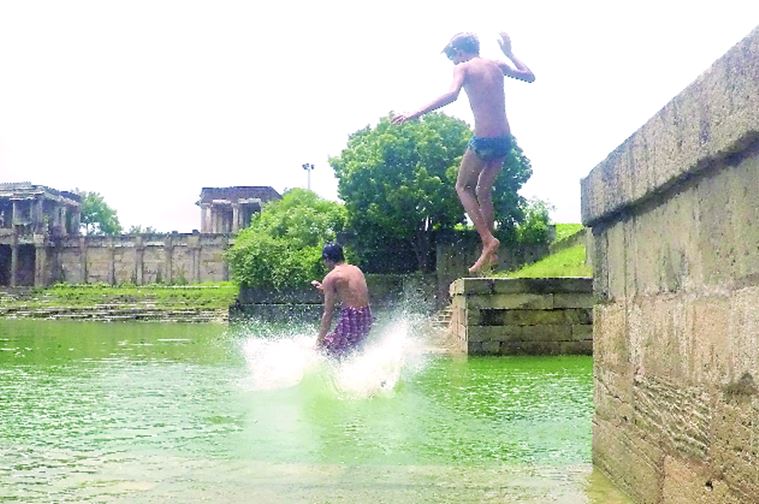Our cities are constantly evolving: Architect and historian Rabindra Vasavada
Architect and historian Rabindra Vasavada’s efforts to have 606-year-old Ahmedabad be declared a World Heritage City have borne fruit this year.
 At home with the world: Rabindra Vasavada. (Source: Raju Shukla)
At home with the world: Rabindra Vasavada. (Source: Raju Shukla)
Cities are more than physical spaces. They have within them the ability to create powerful sets of images, values and myths that sustain us. This year, as 606-year-old Ahmedabad rose to the challenge of being declared a World Heritage City by Unesco on July 8, Ruchira Kamboj, Permanent Representative of India to Unesco, and Professor Rabindra Vasavada, sat in World Heritage Committee Meeting in Krakow, Poland, nervous and reassured all at once. The World Heritage Committee member countries were unanimous in their support for India. Ahmedabad now joins an illustrious list of cities — Paris, Edinburg, Cairo, Bhaktapur and Galle. Vasavada, who has worked with Louis Kahn on the Indian Institute of Management in Ahmedabad, has been engaged with the Old City since 1976. In an interview, he shares the process of nomination, preparing the dossier, and the difference in the East-West approach to heritage.
Excerpts:
What, in your opinion, has sustained Ahmedabad for over 600 years?
It is the spirit of entrepreneurship and its community-oriented bondage, its inter-communal inter-dependence in economic partnership, and the ever-progressive tendencies and openness in adapting to change while retaining a traditional culture. The idea of trusteeship, with philanthropy and benevolence, has been a part of city’s culture.
You’ve been working on Ahmedabad as a historic city for over four decades; you helmed the conservation course at the Centre for Environmental Planning and Technology (CEPT). Tell us about your journey.
I joined the School of Architecture, Ahmedabad (now CEPT) as visiting faculty in 1976. That’s when I began my studies on the Old City. In 1979, Unesco gave a grant to the School, to study cultural influences on architectural expression. They’d chosen Ahmedabad and Tokyo, and we were asked to make monographs. For this study, I started documenting the houses in the Old City. Even after the monograph was submitted in 1980, I continued studying the old city, with the help of my students. Much of the research done by my students was shown at an exhibition organised by the CEPT Archives, recently in Ahmedabad.
You created a different curriculum at CEPT for the post-graduate course in Architecture and Settlement Conservation.
In 2007, I was invited to start a regular post-graduation course in conservation. In those days, the focus in other schools was on urban conservation, while at CEPT, it was oriented towards architectural and settlement conservation. The proposed course that I worked out was vetted by Sir Bernard Feilden, a world-renowned conservationist and an adviser to INTACH. But in 2014, my contract with CEPT ended and the two-year duration PG programme in conservation was suspended.
 A boy jumps into the Sharkhej lake in Ahmedabad. (Source: Javed Raja)
A boy jumps into the Sharkhej lake in Ahmedabad. (Source: Javed Raja)
How did you get involved with the dossier for the World Heritage City?
During my tenure at CEPT, I was helping Unesco on numerous projects in their culture division. During one of our conversations with Nicole Bolomey, the then project head in culture division at the Unesco office in Delhi, she suggested that Ahmedabad should apply for World Heritage status, to celebrate the 600th anniversary of the city in 2011. The then municipal commissioner immediately agreed to the idea, and Ahmedabad Municipal Corporation decided to support and fund the entire effort as a part of their commitment to heritage efforts in the city. It also signed a MoU with CEPT and the Centre for Conservation Studies (CCS) for coordinating the project.
The work to prepare the entire dossier-related tasks was entrusted to the CCS at CEPT. The Unesco accepted the application and a tentative list nomination document was prepared by the CCS, CEPT and submitted to Unesco. On March 31, 2011, Unesco announced the inclusion of Ahmedabad in the tentative nomination list for World Heritage, and following this, CCS and I had the responsibility of preparing the dossier. My conservation students and young architects from different schools were my constant assistants in dealing with survey and upgradation work on the historic city. They became one with the city and its residents.
Our cities are very different from the West. How do they review the criteria then?
This was a debate we had with the Unesco team at the international conference in Ahmedabad in 2010, too. Our cities are constantly evolving. One has to understand the forces through which this evolution happens. In Ahmedabad, economies have undergone transformation of trade, commerce and industry, and from textile to jewellery, and back. One has to view heritage in this evolving scenario.
If one believes that nothing can change, or change has to be continuous only in one way, it’s not possible in an Indian or Asian environment, because, for us, continuity is a stream. It can have different branches, and have a different character, but that doesn’t mean it’s not part of that continuity. We measure time in a very different way. You can’t forget cultural specificities. What is universal is what one needs to find out, at the level of human values and its creative skills and spirit. What is it that will appeal to humanity at large?





- 01
- 02
- 03
- 04
- 05






















